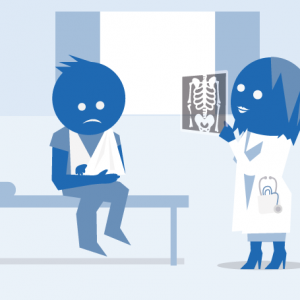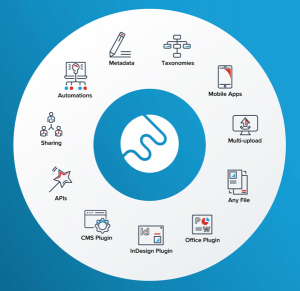Digital Asset Management (DAM) – made in Norway
The market for Digital Asset Management (DAM) software is exploding. With projected double-digit growth rates, customers are expected to spend close to USD 6 billion on such software by 2022. With the shift from pre-paid on-site licenses to cloud-based Software-as-a-Service paid as subscriptions, DAM may well be one of the fastest-growing markets in the software industry.
I confess that I had to look up the name FotoWare when I received the message from Truls Starckjohann. He had read my book, Building Successful Partner Channels. He wanted to discuss how they could better work with the channel to boost revenue.
I get such inquiries regularly and have become used to the fact that there is no relationship between geographic location and the origin of the software. According to popular belief, Silicon Valley is the place where software grows just like Tahiti is the place from where we get vanilla. Diamonds are from South Africa, and wool comes from Shetland. Silicon Valley may be the home of some of the global brands we all know (Google, Apple and Facebook), but software, and especially business software, comes from all over the place.

Jumping to the contact page, I saw that FotoWare originates from Oslo, Norway. Then my curiosity was immediately ignited. I love Norway (they have mountains!), and Oslo is a place I enjoy going to also because it is only about an hour’s flight from Copenhagen. But I was equally intrigued by the international spread of their customer base including some very prestigious names (the White House, the Financial Times, Hamburg Polizei and Marks & Spencer). I am supposed to be a software industry specialist and here was a company right under my nose, with an impressive global presence, and I had never heard of them.
After having had a conversation with Truls and CEO, Anne Gretland, we agreed on a date for a workshop, and I started digging deeper.
A picture editor has a problem

FotoWare was started in the mid-1990s by Ole Christian Frenning and Anders Bergman. Ole Christian, previously a professional photographer, was the photo editor at the Norwegian newspaper, Aftenposten. Images were increasingly born digital, and Ole saw the opportunity of using IT to make his job more comfortable and productive. Thus, FotoWare started as an internal application at Aftenposten. It soon became apparent, however, that every media company in the world could benefit from the solution. Anders, the leader of development at Hasselblad Electronic Imaging, also had the contacts to other potential customers in the world of professional photography. The result of their collaboration made them pioneers into digital asset management systems, although that term wasn’t even coined then.
The requirements for improved management of digital assets turned out to be universal indeed, and the software needed was virtually the same across borders. The software travelled very easily, and the global customer base grew accordingly. Today FotoWare has more than 250.000 users and more than 4.000 business customers in 34 countries around the world.
Why me, why now?

“There are three main reasons why we need to revisit our go-to-market approach now,” explains Anne Gretland. “The first reason is that Digital Asset Management is becoming something all companies need. Just like they need CRM and ERP. The second reason is that the shift from on-premise software to the cloud-based Software-as-a-Service delivery format changes the playing field for our industry, and we need to be inline (or preferably ahead) of that. And the third reason is GDPR. No company want to run the risk of having to pay huge fines for violating the law of using images. All in all, the market is exploding just now, and we have the products that the market wants. We need to ensure that we also have the distribution capacity in place to get our fair share of the market.”
Looking into the reports of the industry analysts it very much seems that Anne Gretland’s predictions are spot on. The market for DAM-systems is expected to grow with double-digit rates in the coming years. If that growth is happening at the same time as the SaaS-format is replacing the prepaid perpetual licenses, then the increase in the number of new customers will be no less than phenomenal. We may be looking into a business opportunity matching the situation in the ERP-market in the years before the Millennium.
Digging deeper into the DAM-world, I realise that even my small publishing and consulting company need it. We have thousands of media and image files spread over numerous folders and filesystems. Some are on Dropbox, some on OneDrive and some on iCloud. We have no control over where we have used which file, how many variations of the same file that exists, if a newer version is available, or if we have consent from people appearing on a media file and which publication rights each file has. As a consequence, we were recently approached by a media agency accusing us of violating the IPR of one of their clients. We had used an image to which we hadn’t acquired the rights. That’s pretty embarrassing for a publishing company.
We paid and apologised.

Media theft is an increasing problem. Finding images on Google is dead easy, but you do not have the right to use most of these unless you acquire the rights from the image-owner. Thanks to improvements in image recognition technology, agencies specialising in revealing and prosecuting theft help the owners to protect and monetise their work.
Therefore, I do agree with Anne Gretland. All companies need a DAM-system. Not only because we use far too much time searching for media files and replacing them with updated versions.
Same files – different needs
Reading through the FotoWare case stories, it becomes apparent that the user situations differ substantially across industries and with the size and nature of the organisation.
A newspaper needs to manage vast historical archives as well as large volumes of new images working towards very tough deadlines. A retail company needs to use images for different communication channels (such as the weekly printed promotional paper, the webshop, in-shop promotions, etc.) and the images come from all types of sources. A multinational company needs to ensure that corporate identity guidelines are respected across borders. A law enforcement organisation needs to immediately share media files for forensic and investigative purposes as well as have meticulous control of which files to use when they present the cases at court.
The DAM functionality is essentially the same, but the priorities change according to the user. That’s wonderful for a software company because it means that the same application can be used across industries. Still, it does represent a marketing communication challenge. Customers, in general, want assurance from their industry peers and are reluctant to accept user case stories from other industries that they do not fully understand.
DAM-as-a-platform
Reading the case study from Medialogix, a UK FotoWare reseller, about the use of FotoWare in healthcare, I come to learn the benefits of providing DAM as a platform with a well-documented API.

The National Health Service in Wolverhampton use clinical photography in the hospital wards, theatres, outpatient clinics and photographic studio for monitoring and assessing patient’s medical conditions, assisting treatment planning and providing educational material for medical and surgical students and staff. Due to the diverse geography of community patients, the photography of wounds and pressure ulcers need to be carried out by the community nursing teams in the patient’s homes. The capture of images outside the controlled environment of the hospital turned out to be associated with all types of problems.
Medialogix developed the Clinical Uploader App to solve the problems.
“The easy to use App provides end-to-end control of the photographic procedure with full auditing, assurance of correct patient identification and consent and a secure transfer process to improve your workflow and minimise governance risks within your organisation.”
The Clinical Uploader App is an excellent example of how value-added resellers and independent software vendors can build a business on top of the FotoWare platform.

“The need for Digital Asset Management is everywhere,” says Truls Starckjohann. “However, the specifics may differ substantially across industries. We rely on our partners to understand the individual customer’s situation and design a solution that meets the requirements. Adding this layer of customisation and helping with the implementation is an attractive business opportunity for our partners.”
Using FotoWare
Returning from Oslo, I signed up for FotoWare. After a one hour webinar with Customer Engagement Manager, John-Fredrik Engeland, I was ready to start migrating our huge library of illustrations to the cloud. Moving all images from one place to another and tagging them up for future searches may seem like a daunting housekeeping task. It’s like eating an elephant or climbing Mount Everest, so I decided to approach it that way.

I divided the project into small chunks of time slots.
Using idle time when travelling or in between other tasks, I managed to get most of the inventory migrated in 30 days. All new images now go directly into FotoWare. The remaining images in the inventory get migrated when I come across them. It may take the rest of the year to get fully converted, but I can already now reap the benefits.
With FotoWare I can find any image in a split second, crop, resize and download it for the document I’m working on (such as this article). I can find all images used in a specific publication, all images from a certain source and on any subject.
The mistake we made using an image to which we didn’t have the rights are definitely over.
FotoWare rocks!








